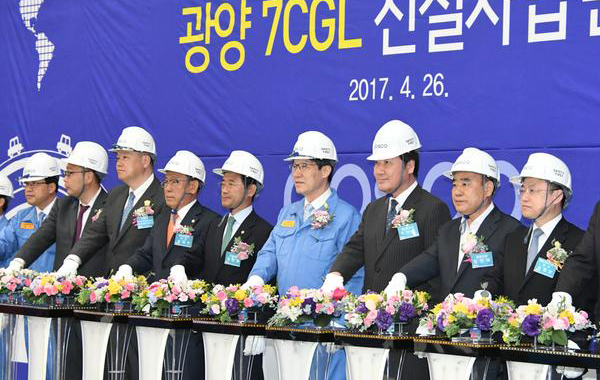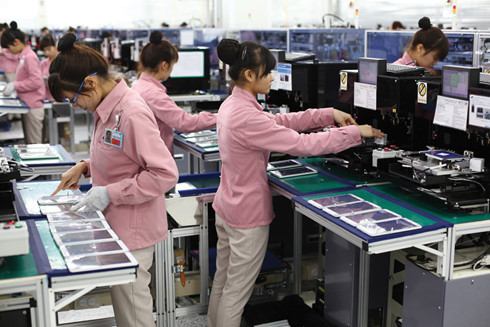Windfall of South Korean high ballers
Surprise, surprise
It might come as no surprise, but the nine high-earning corporations are all closely related to the industry lines that make South Korea South Korea. There is no lack of the renowned technological giants, either, as Samsung, LG, and Hyundai have all made it to the list compiled by The Korea Times.
| Corporation | Operating profit (KRW trillion)* |
| Samsung Electronics | 9.89 |
| SK hynix | 2.47 |
| POSCO | 1.2 |
| Shinhan Financial Group | 1.29 |
| Hyundai Motor | 1.25 |
| LG Display | 1.02 |
| SK Innovation | 1.36 |
| Korea Electric Power Corp. | 2.46 |
| SK C&C | 1.5 |
| * operating profit figures come from a variety of sources, the original list didn’t mention all of them |
Let us have a look at the performance and prospects of South Korea’s most successful nine companies as well as their current status in Vietnam.
Samsung Electronics
According to The Korea Times, Samsung Electronics (SE) has been a longtime member of the trillion won club. Without fault, SE has reported an operating profit of KRW9.89 trillion for the first quarter of 2017, its highest profit since 2013.
SE’s success comes as somewhat of a surprise, considering the rough year the company is looking back on. The corporation sailing without a captain, as chairman Lee Kun-hee is currently hospitalised and his son, the de facto leader of Samsung Group, is spending time in prison for bribery charges related to one of the biggest political scandals of South Korea in the past decade, which led to the impeachment of President Geun-hye.
 |
| Overheating Galaxy Note 7 devices were just one problem for Samsung Electronics this year |
In addition, the company suffered heavily both in prestige and profit due to the Galaxy Note 7 fiasco, after several devices overheated while charging, resulting in fires. The ensuing recalls, replacements, and the eventual worldwide recall and stopping of production taxed the company. On October 17, 2016, as covered by VIR, Samsung Electronics forecasted that its profits would take a plunge of approximately $3.1 billion in the next two quarters. For the first quarter of 2017, SE was expecting a loss of $890,000 in profit.
However, according to The Korea Times, the booming chip market lent a hand to the world’s largest chipmaker to bounce back from adversity.
In Vietnam, Samsung Electronics has four significant operations, including two Samsung Vietnam Electronics manufacturing facilities in Bac Ninh and Thai Nguyen provinces worth $2.5 and $5 billion, respectively, and Samsung Vina Electronics in Ho Chi Minh City, as well as a $300-million R&D facility in Hanoi.
SK hynix
This semiconductor producer has been on the market for 30 years and has grown up to be the world’s second-largest chipmaker, following Samsung Electronics. SK hynix has been posting rosy results throughout 2016 and the first quarter of 2017, reporting an all-time high operating profit of KRW2.47 trillion ($2.17 billion) this quarter, topping the previous record of KRW1.66 trillion ($1.4 billion) in 2014.
SK hynix’s results this past year and this past quarter are nothing short of astounding. The KRW2.47 trillion operating profit if 339 per cent higher than in the first quarter of 2016 and represents a 61 per cent increase on-quarter, as well. To spell it out, according to the company’s website, its total 2016 operating revenue was KRW3.2 trillion ($2.86 billion), meaning the company made a little more than 77 per cent of last year’s entire operating profit in just three months.
SK hynix has four production facilities in Wuxi and Chongqing (China) and domestic business sites in Icheon and Cheonju (South Korea). In addition, it has sales subsidiaries in 10 countries and four R&D corporate bodies in Italy, US, Taiwan, and Belarus.
SK hynix has one subsidiary office in Hanoi.
POSCO
On March 30, Reuters published that South Korea’s heavyweight steelmaker has produced a jump of more than 80 per cent in quarterly operating profit, due to “solid steel demand in China amid rising prices.” According to POSCO’s estimations, it has generated an operating profit of KRW1.2 trillion ($1.07 billion) in this quarter.
According to POSCO’s consolidated income statement, the company has been generating growth in operating profit at a steady rate throughout 2016, reaching the KRW1 trillion mark by the third quarter, when it hit KRW1.034 trillion ($924.67 million).
This is a hefty increase over the first quarter of 2016, when the company’s operating income was “only” KRW660 billion ($590.2 million).
POSCO has been diligently building its business throughout the year, making news on newswire Business Standard by renewing its supply agreement with Essar Steel. The new agreement will supply 1.1 million tonnes of steel for POSCO’s Indian operations, about 30 per cent more than last year.
Meanwhile, South Korean business newswire Pulse News reported that POSCO has completed the construction of its KRW255.4 billion ($226.5 million) steel production facility No. 7 Continuous Galvanizing Line (CGL) in Gwangyang, South Jeolla.
 |
| POSCO's new facility is the first of its kind in the world |
The No.7 CGL is the world’s first manufacturing facility that is capable of churning out both 1.5 giga-level galva-annealed and galvanised steel sheets, the company said, according to Pulse News, making it a significant addition to the POSCO arsenal.
According to VIR coverage, POSCO is heavily present in Vietnam. In October 2015, Mong Duong II coal-fired thermal power plant, constructed by POSCO, in Quang Ninh province started operations. Additionally, in February 2016, POSCO signed a Memorandum of Understanding with Nghe An province to construct and operate Quynh Lap II thermal power plant in Vinh City. This 1,200MW plant will be built in the Build-Operate-Transfer format, and POSCO will sell the generated electricity to EVN for 25 years, after which it will transfer ownership to the government.
Somewhat more disconcerting is the progress of the Splendora residential project in Hanoi, where POSCO E&C hold a 50 per cent ownership. This project includes shophouses, villas, a 6.6-hectare artificial lake, gardens, trees, international schools, entertainment areas, offices, and shopping areas. However, Splendora has been in limbo since 2012, as Vietnam Construction and Import-Export JSC (Vinaconex), also holding 50 per cent in the project, has been stalling phase 2 to await better market conditions, while POSCO E&C would prefer going forward at the originally planned pace. This disagreement has been on-going since 2014 with no end in sight.
Shinhan Financial Group
According to The Korea Times, Shinhan Financial Group’s first quarter operating profit was KRW1.29 trillion ($1.15 billion) with a net profit of KRW997.1 billion ($8961.7 million), a 29 per cent increase on-year. This performance was surprising as Shinhan Bank, the company flagship, has seen a 7 per cent decline in profit, making KRW523.5 billion ($468.2 million).
The spectacular growth against the usual weight-lifter’s poorer performance was largely due to improved net interest margins and reduced general and administrative expenses, according to Korea Herald, citing a company statement as saying: “While banking and non-banking affiliates improved profits in a balanced manner, the rebound in net interest margins and reduced costs, along with rearrangement of our resources, contributed to the best quarterly earnings result this time.”
In addition, as The Korea Times points out, other Shinhan subsidiaries performed spectacularly, far outweighing Shinhan Bank’s momentary staggering. Subsidiary Shinhan Card reported a net profit of KRW410.8 billion ($367.36 million), up 170 per cent on-year. Similarly, Shinhan Investment Corp. made a net profit of KRW46 billion, up 111 per cent on-year.
In Vietnam, Shinhan Financial Group made the news by buying up Australian bank ANZ’s Vietnamese retail assets. At the same time, Shinhan Bank Vietnam is slowly becoming a threat to domestic competition. As reported by VIR, despite its relatively low chartered capital—only VND4.547 trillion ($200 million)—its 2016 profit exceeded VND1 trillion ($44 million), far outstripping similar-sized domestic banks and all foreign banks in Vietnam. Shinhan Vietnam’s profit was lower than HSBC Vietnam’s only.
Additionally, even before the ANZ deal, Shinhan Vietnam had been continuously expanding its network. In the middle of April 2017, the State Bank of Vietnam permitted it to open a representative office and four branches and transaction offices in Hanoi and Ho Chi Minh City.
Hyundai Motor
The South Korean carmaker’s operating profit was down 6.8 per cent during the first quarter of the year, but it still managed to reach KRW1.25 trillion ($1.12 billion), against last year’s KRW1.34 trillion ($1.2 billion).
The Korea Times explained this somewhat lacklustre performance by significant losses in the Chinese market, courtesy of Beijing’s retaliatory measures after the deployment of the US anti-missile shield. Accordingly, the unit sales of Hyundai Motor and affiliate Kia Motors fell by 52.2 per cent on-year, and are experiencing further troubles: Hyundai’s sales fell by 44.3 and 64 per cent on-quarter in March and April.
Nevertheless, the company remains upbeat regarding its global prospects, hoping to bank in on its technological edge and brand power.
In March 2017, Hyundai signed an agreement with Thanh Cong Group to boost production in Vietnam. With this extended capacity, the Vietnamese production base will be able to start exporting vehicles. The move was meant to facilitate Hyundai’s expansionary goals in the ASEAN.
LG Display
While last year LG Display was nowhere close to be featured on the South Korean high-earners’ list, it has recorded its highest-ever quarterly earnings recently. While the company’s operating profit in the first quarter of 2016 was only KRW39.5 billion ($35.3 million), it made KRW1.02 trillion ($912 million) this quarter.
This almost 26-fold increase in operating profit, as forecast by Financial Times, is going to carry into the second quarter, with similar panel shipments and stable prices.
However, not everything is entirely sunny. Financial Times reported heavy concerns among LG Display’s investors about the company’s outlook in the coming quarters. In particular, investors are worried that increasing panel prices may dampen demand from television makers and that Apple will likely adopt OLED screens for its new iPhone product coming out later this year, a contract Samsung Display might snatch up from under LG Display’s nose.
 |
| LG Display's manufacturing facility in Bac Ninh province |
In Vietnam, LG Display inaugurated its $1.5-billion manufacturing complex in Trang Due IP to produce price-competitive electronic goods. A year later, the company signed a Memorandum of Understanding with the Haiphong People’s Committee for a hi-tech OLED production facility, doubling its investment in Vietnam.
Mirroring LG Display’s current global state of affairs, the robustly increasing investments are overshadowed by worrying news. In January this year, the General Department of Vietnam Customs requested LG Electronics Vietnam (an LG Display subsidiary) to pay VND1.8 billion ($79,362) in tax arrears.
SK Innovation
This leading global Korean energy and chemical company has produced an 18.9 per cent increase in operating profit against last year, reaching KRW1.36 trillion ($1.2 billion). This is the first time the company breaks the KRW1 trillion threshold in quarterly operating profit since 2011.
The company’s success was due to the great growth generated in its chemical business. According to experts, SK Innovation’s proactive chemical and lubricant investments are finally showing results.
Indeed, as The Korea Times reports, SK Innovation has invested nearly KRW5 trillion ($4.47 billion) over the past five years in its Incheon production facilities, its Chinese petrochemical affiliate, and its aromatics facilities in Ulsan.
In Vietnam, as reported by VIR, SK Innovation signed a petroleum sharing contract in April 2017 with US Murphy Oil Corporation and PetroVietnam Exploration Production Corp. Accordingly, the three parties will cooperate to exploit block 15-1/05 in Cuu Long Basin (offshore Vietnam).
Korea Electric Power Corp. (KEPCO)
The Korean energy provider reported an operating profit of KRW2.46 trillion ($2.2 billion), a marked decline since last year’s KRW3.61 trillion ($3.23 billion). The fall was expected though, as electricity prices have been steadily decreasing and the price of liquefied natural gas has been going up.
According to Seeking Alpha, KEPCO’s operating revenue shrank by 3.4 per cent this quarter, to KRW15.15 trillion ($13.6 billion), mainly due to a 1.7 per cent decrease in power sales revenue and a sharp, 30.1 per cent decrease in revenue from overseas business lines.
As previously covered by VIR, KEPCO and Marubeni Corp from Japan signed the investment agreement to construct Nghi Son II thermal power plant. The project will be located in Nghi Son Economic Zone and will have a capacity of 1,200MW. It will have a total investment capital sum of $2 billion.
What the stars mean:
★ Poor ★ ★ Promising ★★★ Good ★★★★ Very good ★★★★★ Exceptional
Latest News
More News
- Government moves to establish International Financial Centre (December 21, 2025 | 21:00)
- Vietnam's IFC to target global investment flows (December 21, 2025 | 18:00)
- Two national hospitals expand capacity with new facilities (December 20, 2025 | 09:00)
- Ha Tinh breaks ground on major Vingroup industrial and energy projects (December 19, 2025 | 18:24)
- EVN launches major power infrastructure projects nationwide (December 19, 2025 | 18:17)
- VAL inaugurates second production line to meet domestic animal feed demand (December 19, 2025 | 16:37)
- Sun Group pioneers urban tram system in Phu Quoc (December 19, 2025 | 15:00)
- Seven major projects launched to drive Hanoi’s next growth phase (December 19, 2025 | 14:00)
- Securing capital and efficiency for Vietnam’s 2026-2030 growth ambitions (December 17, 2025 | 10:00)
- Vietnam bucking trend in the global M&A landscape (December 16, 2025 | 14:20)
















 Mobile Version
Mobile Version